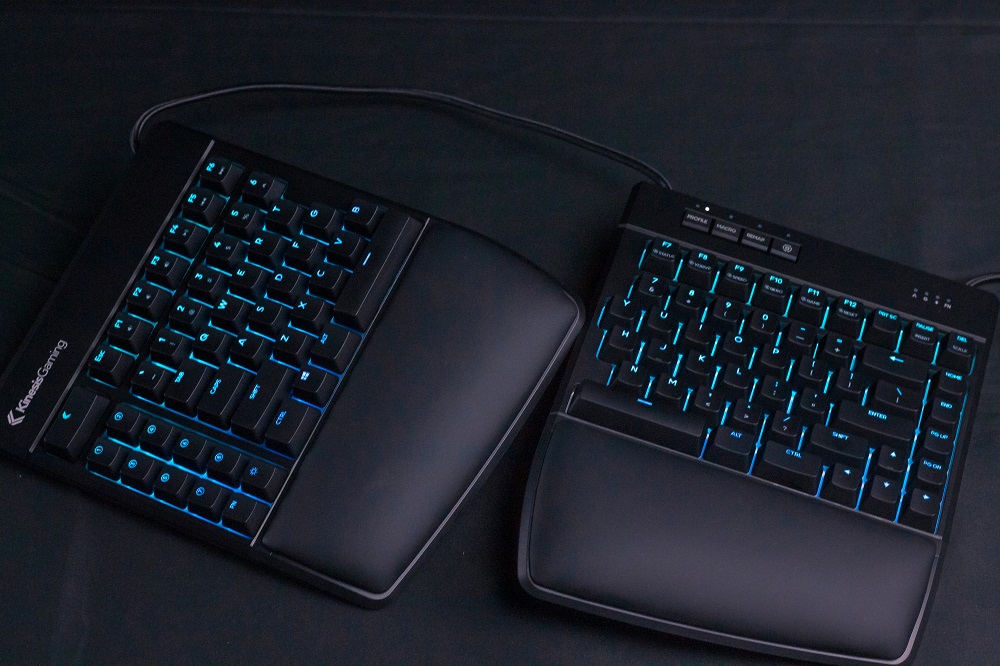I want a keyboard, a Kinesis keyboard.

High Ground Gaming
I’ve wanted this since I turned 30. I’m now 34, I still haven’t bought it.
The upshot of wanting something and not getting it is causing me some distress. Just thinking about it makes my chest heavy, my spine contorts forward, my lungs work harder than ever to pump air to fight back gravity. It’s not a great feeling to have, so why don’t I just buy it?
What’s so great about a keyboard?
My foray into buying an expensive mechanical keyboard started with a little twitch. It was a twitch on my right index finger that I use to type the letter “b”. After mistyping countless words like “beautiful”, “borrow” and “be”, the twitch developed into a nagging pain around my wrist. Before I knew it, I had full-blown RSI (Repetitive Strain Injury), and it forced me to type using hunt and peck.

Trying hard to email
A short meeting with an ergonomics specialist gave me a reason why. “Your right hand is weird. It’s way too tilted to the left when typing,” she said, ” A split keyboard might help.” Just like a doctor, she prescribed me my first split keyboard.
The split keyboard definitely helped reduce the RSI, but I noticed it’s not fully gone. To fully remove it, I had to learn to type “b” with my left hand instead of my right. So I did that and it surprised me how easy it was for my brain to remap the keys. Within a week I started typing “beautiful” with my left hand.
I didn’t stop there. Within a year, I remapped my entire keyboard layout from the standard QWERTY to DVORAK, a layout that’s been optimised for writing in English for right-handed peeps. The main difference is that letters that are highly used like the vowels are put on the middle “home” row where the fingers rest, allowing the typer to hit the row 70% of the time compared to just 32% with the QWERTY layout.
Changing this layout was arduous. It took me four months of re-learning how to type to get back to 80 WPM and the first three weeks was real hell. Each email I had to write at work became an essay, the amount of thinking I had to do to type every single word was so immense, I cut down my email length by half. I was so tired I slept well every night.
I learned about key travel and the joy associated with pressing a single key. Key travel is how far you can press the key until it clicks the bottom. Some keyboards are too shallow, like the controversial butterfly keyboard from Apple, but some keyboards have just the right amount of key travel, where it creates music in my mind when I’m typing. Imagine a piano, you can make interesting sounds with just one note by varying the pressure when playing.
Which brings me back to the Kinesis keyboard. It has everything I wanted now that my old keyboard starts playing up. It has the right key travel feel, it is a split keyboard and it’s wireless! Wow, everything in one, I am speechless this thing exists.
Craving leads to aversion and aversion leads to craving
I’ve meditated on to buy or not to buy for years. I don’t mean figuratively, I mean literally. When I went to a Vipassana meditation course, I learned to recognise this basic human emotion as a craving. It’s obvious when a baby wants something. They point at the thing they want. When they can get it, they become joyful. When they don’t, they show distressing signs like crying.

Showing distress
As we get older we’ve developed more complex emotions and therefore detach ourselves from associating our wants from the finger-pointing and the weeping. Despite this, human basic emotions are basic because they are universal. We have them as adults, we are just less aware of them.
During meditation, they trained me to recognise distress as an aversion. It’s that feeling when you want to get away from something. Like when you have a loud construction site outside your home, it is hard to concentrate since your aversion to the noise builds up over time.
Buddha became enlightened when he made the link between craving and aversion. Craving leads to aversion and aversion leads to craving. When you crave something like freedom, you start hating your job, and since you hate your job you crave quitting much more. It’s a never-ending cycle.
The answer, according to Buddha is not to give in to craving or aversion, instead, to not react to them.
What’s next?
Now I’m no Buddha, so I don’t follow what he said completely. Reacting sometimes feels inevitable, but I see benefits in reducing the rumination.
Overthinking about the keyboard is the reaction to avoid. Everything else is fine. I haven’t decided on the keyboard, but I’ve decided to stop thinking about it.
It reminds me of a Seth Godin story: imagine a donkey in between a pile of hay and a bucket of water. It is both hungry and thirsty, but it can’t decide which one it wants more. It is paralysed by indecision.
I want to reach Buddha’s enlightenment, but what I want more is not to be a donkey.